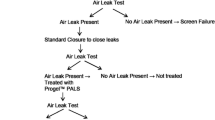Abstract
Many synthetic materials are being used in order to reduce the frequency of prolonged air leak (PAL) in thoracic surgical practice. This study presents our experience with the topical application of acrylate co-monomer (Glubran-2) as a synthetic tissue adhesive in an attempt to decrease troublesome postoperative air leaks in patients undergoing resection for non-small cell lung carcinoma. Of the 112 patients who had undergone resection for lung carcinoma, 69 patients having lobectomy or bilobectomy were included in this study. The application group (group A) consisted of 33 patients where a synthetic tissue adhesive (Glubran-2) was used and compared with the control group (group C, n = 36) retrospectively. There was no difference between the groups regarding demographic details and operative variables. Both groups were compared in view to PAL, chest tube duration, in-hospital stay and hospital costs. There was no significant difference between group A (n = 11, 33 %) and group C (n = 6, 17 %) for the development of PAL (P = 0.11). Hospital stay was 16.1 ± 6.7 days in group A and 15.3 ± 5.8 days in group C (P = 0.66). The surgical cost was significantly higher in group A (€806 ± 127) than the group C (€624 ± 94) (P < 0.001). There was no significant difference between the groups regarding overall hospital costs (P = 0.41). In this study, the use of Glubran-2 following lung resection for non-small cell lung carcinoma did not decrease the incidence of PAL. Neither did it have a favorable effect concerning in-hospital stay nor did it decrease overall hospital costs while increasing surgical costs as expected.

Similar content being viewed by others
References
Cerfolio RJ, Bass CS, Pask AH et al (2002) Predictors and treatment of persistent air leaks. Ann Thorac Surg 73:1727–1731
Cerfolio RJ, Tummala RP, Holman WL et al (1998) A prospective algorithm for the management of air leaks after pulmonary resection. Ann Thorac Surg 66:1726–1731
Ohri SK, Oswal SK, Townsend ER et al (1992) Early and late outcome after diagnostic thoracoscopy and talk pleurodesis. Ann Thorac Surg 53:1038–1041
Abolhoda A, Liu D, Brooks A et al (1998) Prolonged air leak following radical upper lobectomy: an analysis of incidence and possible risk factors. Chest 113:1507–1510
Wain JC, Kaiser LR, Johnstone DW et al (2001) Trial of a novel synthetic sealant in preventing air leaks after lung resection. Ann Thorac Surg 71:1623–1629
Porte HL, Janny T, Akkad R et al (2001) Randomized controlled trial of a synthetic sealant for preventing alveolar air leaks after lobectomy. Ann Thorac Surg 71:1618–1622
Allen MS, Wood DE, Hawkinson RW et al (2004) Prospective randomized study evaluating a biodegradable polymeric sealant for sealing intraoperative air leaks that occur during pulmonary resection. Ann Thorac Surg 77:1792–1801
Lang G, Csekeo A, Stamatis G et al (2004) Efficacy and safety of topical application of human fibrinogen/thrombin-coated collagen patch (TachoComb) for treatment of air leakage after standard lobectomy. Eur J Cardiothorac Surg 25:160–166
Belboul A, Dernevik L, Aljassim O et al (2004) The effect of autologous fibrin sealant (Vivostat) on morbidity after pulmonary lobectomy: A prospective randomised, blinded study. Eur J Cardiothorac Surg 26:1187–1191
McKenna RJ, Fischel RJ, Brenner M et al (1996) Use of the Heimlich valve to shorten hospital stay after lung reduction surgery for emphysema. Ann Thorac Surg 61:1115–1117
Ponn RB, Silverman HJ, Federico JA (1997) Outpatient chest tube management. Ann Thorac Surg 64:1437–1440
Lodi R, Stefani A (2000) A new portable chest drainage device. Ann Thorac Surg 69:998–1001
Rieger MK, Wroblewski AH, Brooks AJ et al (2007) Postoperative outpatient chest tube management: initial experience with a new portable system. Ann Thorac Surg 84:630–632
Irshad K, Feldman LS, Chu VF et al (2002) Causes of increased length of hospitalization on a general thoracic surgery service: a prospective observational study. Can J Surg 45(4):264–268
Belda-Sanchis J, Serra-Mitjans M, Iglesias Sentis M, Rami R (2010) Surgical sealant for preventing air leaks after pulmonary resections in patients with lung cancer. Cochrane Database Syst Rev 20;(1):CD003051
Gündoğdu AG, Yazıcıoğlu A, Kara M et al (2006) The use of tissue glue and its effect on hospital cost in patients undergoing pulmonary surgery. Tuberk Toraks 54(2):157–160
Anegg U, Lindenmann J, Matzi V et al (2007) Efficiency of fleece-bound sealing (TachoSil) of air leaks in lung surgery: a prospective randomised trial. Eur J Cardiothorac Surg 31:198–202
Author information
Authors and Affiliations
Corresponding author
Rights and permissions
About this article
Cite this article
Alar, T., Ceylan, K.C., Duman, E. et al. Is Acrylate Co-monomer (Glubran-2) Useful in the Prevention of Prolonged Air Leaks After Pulmonary Lobectomy?. Indian J Surg 75, 373–376 (2013). https://doi.org/10.1007/s12262-012-0522-8
Received:
Accepted:
Published:
Issue Date:
DOI: https://doi.org/10.1007/s12262-012-0522-8




